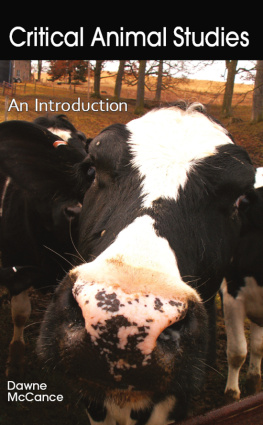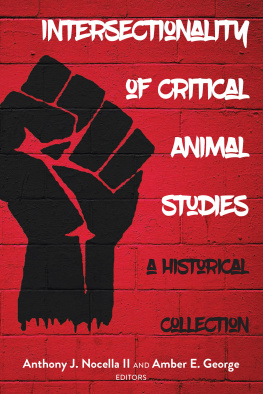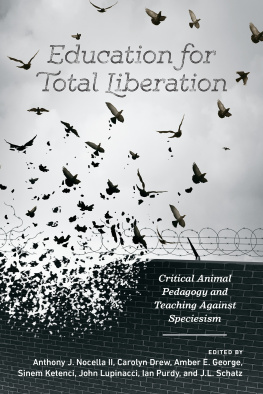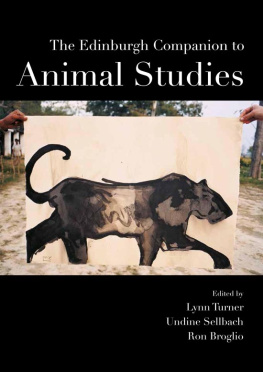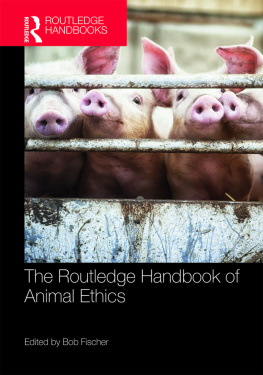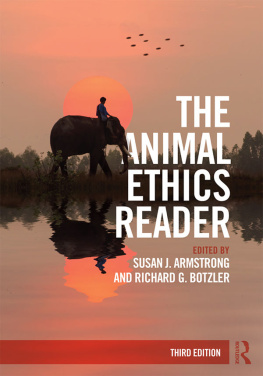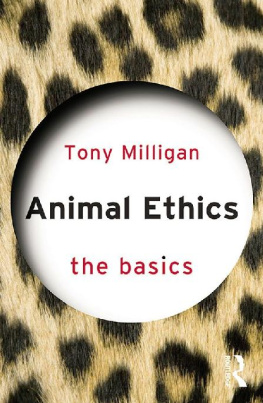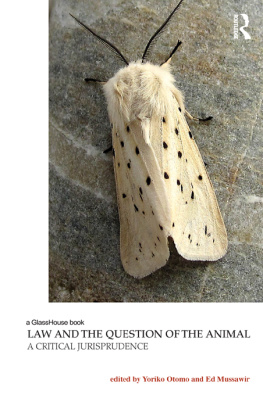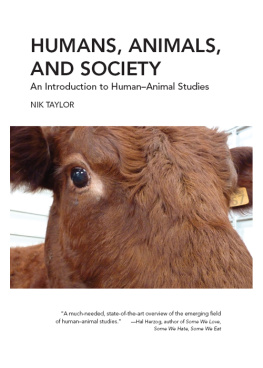CRITICAL
ANIMAL
STUDIES

AN INTRODUCTION
Dawne McCance

Published by State University of New York Press, Albany
2013 State University of New York
All rights reserved
Printed in the United States of America
No part of this book may be used or reproduced in any manner whatsoever without written permission. No part of this book may be stored in a retrieval system or transmitted in any form or by any means including electronic, electrostatic, magnetic tape, mechanical, photocopying, recording, or otherwise without the prior permission in writing of the publisher.
For information, contact State University of New York Press, Albany, NY
www.sunypress.edu
Production by Diane Ganeles
Marketing by Anne M. Valentine
Library of Congress Cataloging-in-Publication Data
McCance, Dawane, 1944
Critical animal studies : an introduction / Dawne McCance.
p. cm.
Includes bibliographical references (p. ) and index.
ISBN 978-1-4384-4535-9 (alk. paper) ISBN 978-1-4384-4534-2 (pbk. : alk. paper)
1. Animal rights. 2. Animal welfareMoral and ethical aspects. I. Title.
HV4708.M387 2013
179'.3dc23
2012009562
10 9 8 7 6 5 4 3 2 1
This book is for Erin
PREFACE
Chopped Liver
M y first experience as a graduate student, newly admitted to a master of science program in biochemistry, involved protein synthesis experimentation conducted on rats in a medical science laboratory. Actually, the basement room of the since-condemned and demolished building in which most of this research took place bore little resemblance to the university labs I had imagined or previously encountered. The entire research facility was old and crumbling, the basement area particularly bleak. The animal lab to which my supervisor assigned mea windowless and dimly lighted cellcontained sixty wire mesh cages suspended in rows on a metal frame. A table against one wall held an old, and very dull, guillotinesmaller than a paper cutter, and not nearly as efficient. My assignment as a student researcher was to nurture a new shipment of rats (they arrived soon after I did), that is, to feed them carefully allotted daily portions of a diet formulated to determine the ingredients essential to protein synthesis. I was instructed to weigh the rats daily, and when they achieved the desired mass, to decapitate them, cut open the thorax and remove the liver, and take it to a secondary lab upstairs. There, usually in late afternoon sunlight after my supervisor had left for the day, I would queasily chop the still-warm liver into small pieces, cauterize it in a centrifuge, and do a protein analysis on the results.
In the critical animal studies literature, the rodents favored for laboratory experimentation are not always counted as animals having a strong moral claim. For many, then, my rats would have had lower ontological and moral status than the puppies in the basement lab down the hall from mine, the lab that my student researcher colleagues called their puppy mill. Although I did not give my rats names, such as those Jane Goodall bestowed on her Gombie chimpanzees, one thing I learned in working with them is that, as much as any puppies I have known, and probably much like chimpanzees, each has a personality, temperament, and behavioral features all its own, features I recorded at the time in my journal. Marc Bekoff and Jessica Pierce (28), reporting on the work of neurobiologist Jack Panksepp, suggest that rats are social, experience joy, and laugh when tickled. I can assert that they squeal and scream in pain. They also demonstrate intelligencethe sort of intelligence a rat needs to determine how one's own cage might be pried open, and in turn the cages of one's fellow rats. When only five of the animals had been brought to the guillotine, this was the kind of rat intelligence that, somewhat to my relief but much to my supervisor's chagrin, put an end to the protein synthesis experiment: an overnight rebellion of rats releasing rats, and large rats eating small ones. The event brought not only a catastrophic halt to that summer's research, but also, with my decision to forego a career in experimental science, the close of my study of biochemistry. I remember my father's dismay at the news that I was withdrawing from the biochemistry graduate program, and my feeble answer to his question why: If I study and teach philosophy, I won't have to spend my life cutting off heads.
At the time, I was clearly unaware of the nonliteral putting to death, in which, as Jacques Derrida observes, philosophy and other humanist discourses participate to the extent that they do not sacrifice sacrifice (Derrida Eating, 113). Is it fair to say that a sacrificial structure (113) prevails in today's critical animal studies and animal ethics, where one might least expect it to be found? It is a key question with which to open this bookand the question on which the book concludes.
ACKNOWLEDGMENTS
I wish to acknowledge the support of the Social Sciences and Research Council of Canada, St. John's College, and the Department of Religion at the University of Manitoba. Thank you to David Farrell Krell for his support, including his reading of, and interest in, this book. Thank you to my graduate student, Bruce Conan, for proofreading the original manuscript. And thanks to Andrew Kenyon, Diane Ganeles, and the excellent staff at SUNY Press.
INTRODUCTION
N ever mind that the astronomy of Nicolas Copernicus amounted, in Arthur Koestler's words (179), to no more than a ramshackle hodge-podge of epicycles, within fifty years of the 1543 publication of De revolutionibus orbium coelestium (On the Revolutions of the Celestial Spheres), the transition to mechanical philosophy, and thus to modernity, was underway. By the beginning of the seventeenth century, the entire episteme of Western culture found its fundamental arrangement modified, Michel Foucault writes in The Order of Things; the seventeenth century marks the disappearance of the old superstitious and magical beliefs and the entry of nature, at long last, into the scientific order (54). A world previously understood as a complex of kinships, resemblances, and affinities, and in which language and things were endlessly interwoven, gradually gave way to a configuration for which analysis, division into the smallest constituent units, is the fundamental way of knowing, and for which the activity of the mind consists no longer in drawing things together, in setting out on a quest for everything that might reveal some sort of kinship, attraction, or secretly shared nature within them, but, on the contrary, in discriminating, dividing, separating identities from differences (5455). Under this new mode of analysis, the word individual lost the meaning it had in medieval argumentthat which is indivisible, comprehensible only as a whole and indivisible from the whole to which it belongs (Raymond Williams 161165)in favor of its modern connotation: a single, detached, and soon-autonomous entity, itself divisible into lower and higher parts, animal body and animating mind. As will emerge in the following chapters, it is animalscountless and nameless animalswho continue to bear the burden of this modern bifurcation of the living from the dead.
Even before De revolutionibus was put on the Papal Index in 1616, Galileo set the stage for the bifurcation when, peering through his telescope at the moon, he saw, not the heavenly bodies of the ancients, but a barren, dead
Next page
